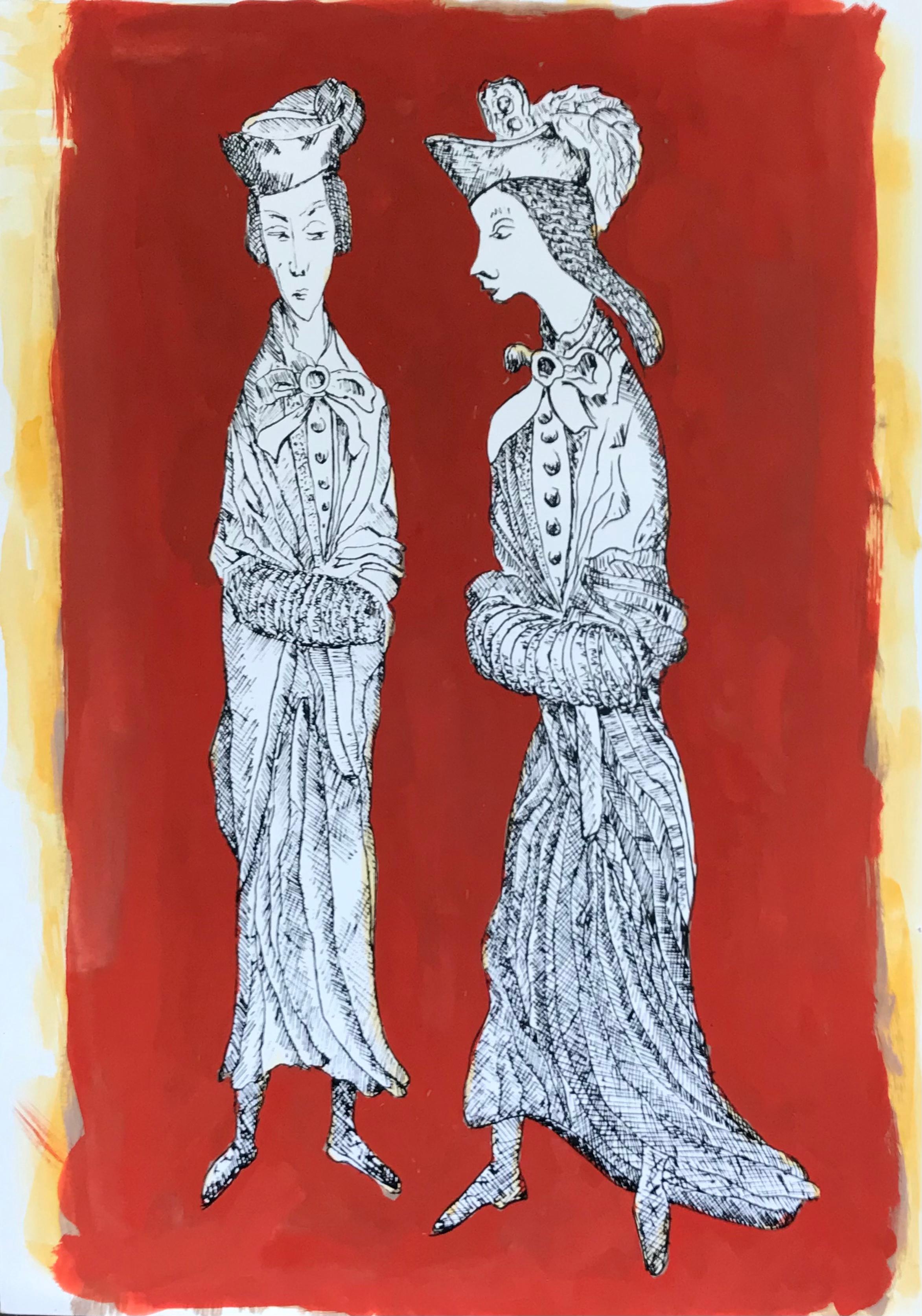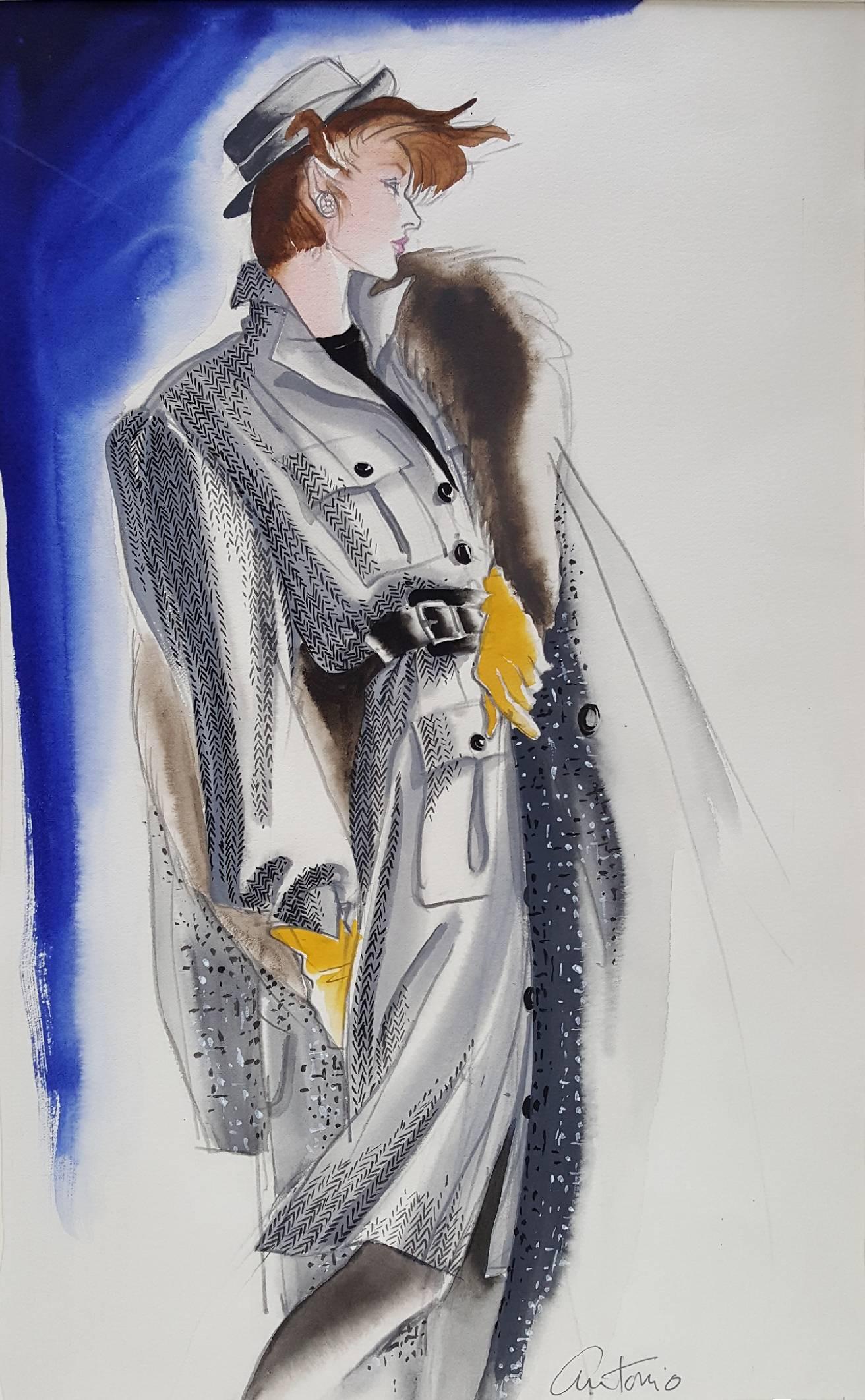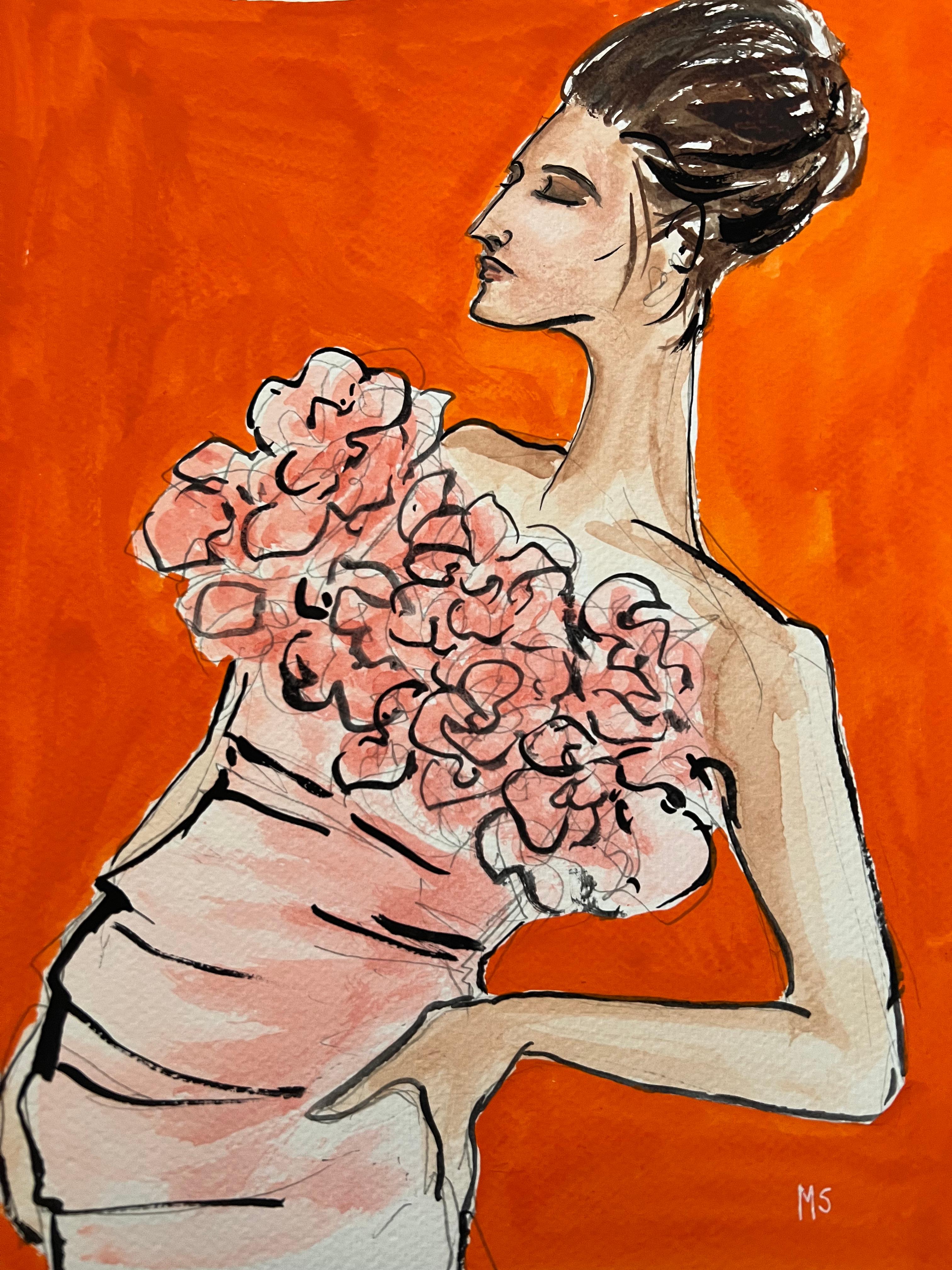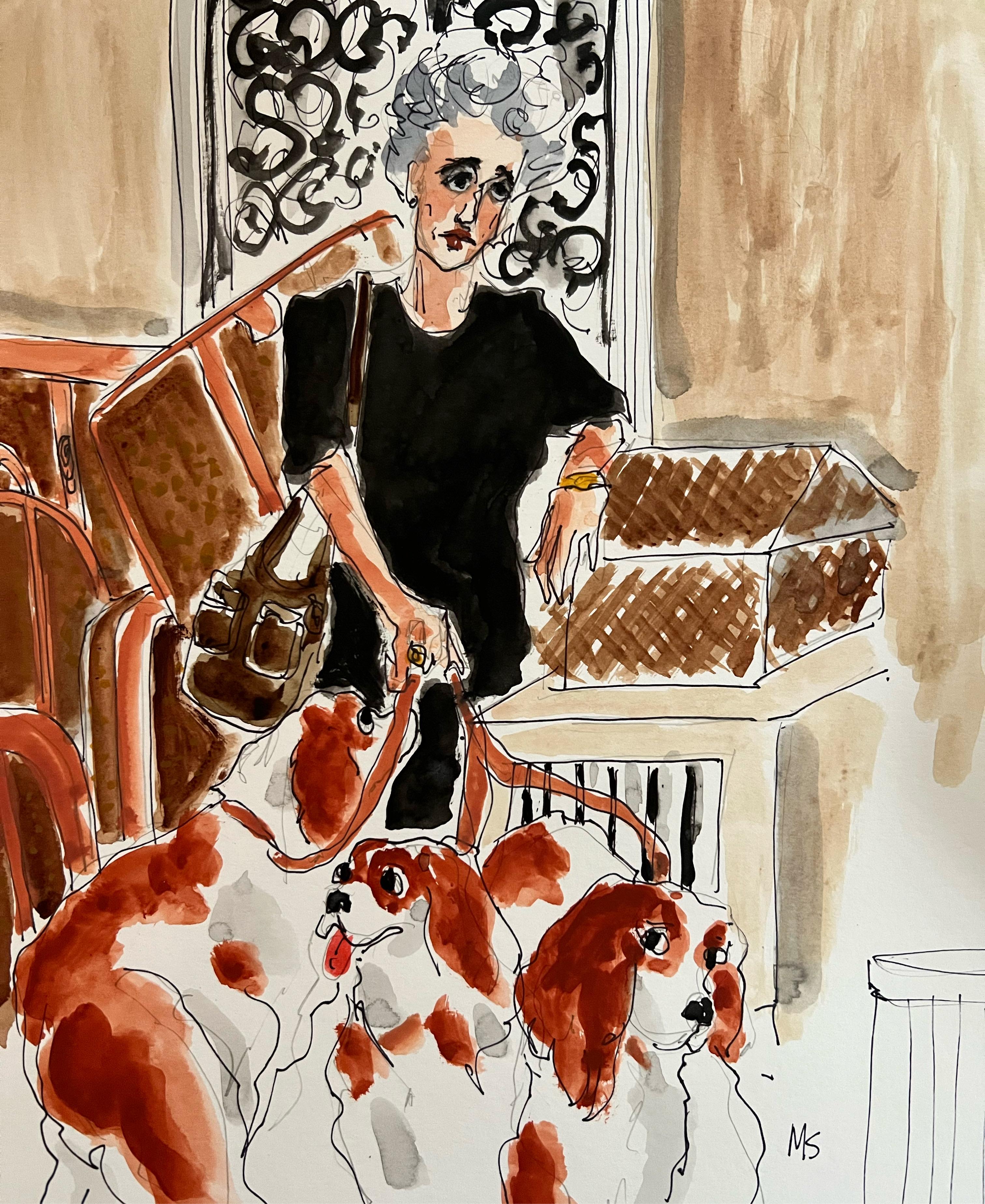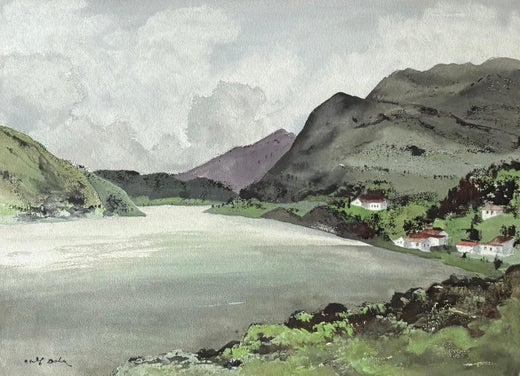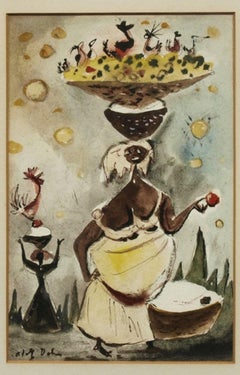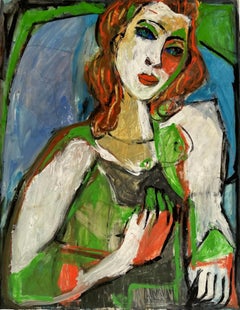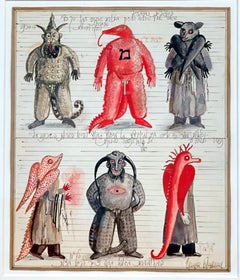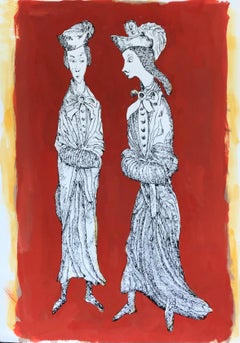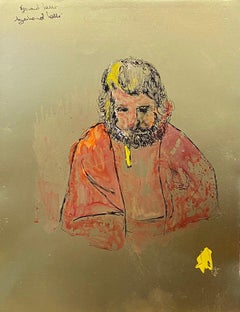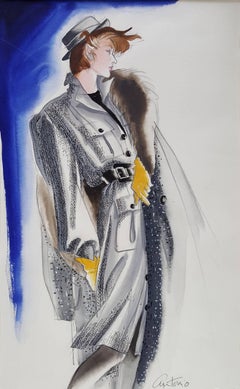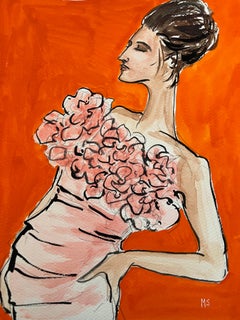Items Similar to Adolf Dehn, Haitian Scene A, signed painting, Associated American Artists, 1950s
Want more images or videos?
Request additional images or videos from the seller
1 of 11
Adolf Arthur DehnAdolf Dehn, Haitian Scene A, signed painting, Associated American Artists, 1950sca. 1951
ca. 1951
About the Item
Adolf Arthur Dehn
Haitian Scene A, ca. 1951
Watercolor gouache on board
Signed on the front
Frame included: held in vintage modern frame
Measurements:
Framed:
11 inches vertical by 13 inches horizontal by .75
Painting
4.5 inches by 6 inches
Watercolor gouache, hand signed; framed with AAA Gallery label verso
Signed on the front bearing the original label on the verso of Dehn's longtime gallery, the prestigious Associated American Artists Gallery, New York City.
Provenance
Associated American Artists
Frame included: held in vintage frame with original label as provenance
Dehn, an influential artist and teacher (and author of the definitive textbook of his era on watercolor painting) joined Associated American Artists gallery in 1941. Although this painting is undated, it is likely circa early 1950s, as in 1951 Dehn won a Guggenheim Fellowship, which enabled him to travel to Haiti -- the subject of this work. It was part of a series inspired by Dehn's visit to Haiti.
Dehn, an influential artist and teacher (and author of the definitive textbook of his era on watercolor painting) joined Associated American Artists gallery in 1941. Although this painting is undated, it is likely circa early 1950s, as in 1951 Dehn won a Guggenheim Fellowship, which enabled him to travel to Haiti.
ADLOF DEHN
Adolf Dehn, American Watercolorist and Printmaker, 1895-1968
Adolf Dehn was an artist who achieved extraordinary artistic heights, but in a very particular artistic sphere - not so much in oil painting as in watercolor and lithography. Long recognized as a master by serious print collectors, he is gradually gaining recognition as a notable and influential figure in the overall history of American art.
In the 19th century, with the invention of the rotary press, which made possible enormous print runs, and the development of the popular, mass-market magazines, newspaper and magazine illustration developed into an artistic realm of its own, often surprisingly divorced from the world of museums and art exhibitions, and today remains surprisingly overlooked by most art historians. Dehn in many regards was an outgrowth of this world, although in an unusual way, since as a young man he produced most of his illustrative work not for popular magazines, such as The Saturday Evening Post, but rather for radical journals, such as The Masses or The Liberator, or artistic "little magazines" such as The Dial. This background established the foundation of his outlook, and led later to his unique and distinctive contribution to American graphic art.
If there’s a distinctive quality to his work, it was his skill in introducing unusual tonal and textural effects into his work, particularly in printmaking but also in watercolor. Jackson Pollock seems to have been one of many notable artists who were influenced by his techniques.
Early Years, 1895 - 1922
For an artist largely remembered for scenes of Vienna and Paris, Adolf Dehn’s background was a surprising one. Born in Waterville, Minnesota, on November 22, 1895, Dehn was the descendent of farmers who had emigrated from Germany and homesteaded in the region, initially in a one-room log cabin with a dirt floor. Adolf’s father, Arthur Clark Dehn, was a hunter and trapper who took pride that he had no boss but himself, and who had little use for art. Indeed, during Adolf’s boyhood the walls of his bedroom and the space under his bed were filled with the pelts of mink, muskrats and skunks that his father had killed, skinned and stretched on drying boards. It was Adolf’s mother, Emilie Haas Dehn, a faithful member of the German Lutheran Evangelical Church, who encouraged his interest in art, which became apparent early in childhood. Both parents were ardent socialists, and supporters of Eugene Debs. In many ways Dehn’s later artistic achievement was clearly a reaction against the grinding rural poverty of his childhood.
After graduating from high school in 1914 at the age of 19—an age not unusual in farming communities at the time, where school attendance was often irregular—Dehn attended the Minneapolis School of Art from 1914 to 1917, whose character followed strongly reflected that of its director, Munich-trained Robert Kohler, an artistic conservative but a social radical. There Dehn joined a group of students who went on to nationally significant careers, including Wanda Gag (later author of best-selling children’s books); John Flanagan (a sculptor notable for his use of direct carving) Harry Gottlieb (a notable social realist and member of the Woodstock Art Colony), Elizabeth Olds (a printmaker and administrator for the WPA), Arnold Blanch (landscape, still-life and figure painter, and of the Woodstock group), Lucille Lunquist, later Lucille Blanch (also a gifted painter and founder of the Woodstock art colony), and Johan Egilrud (who stayed in Minneapolis and became a journalist and poet).
Adolf became particularly close to Wanda Gag (1893-1946), with whom he established an intense but platonic relationship. Two years older than he, Gag was the daughter of a Bohemian artist and decorator, Anton Gag, who had died in 1908. After her husband died, Wanda’s mother, Lizzi Gag, became a helpless invalid, so Wanda was entrusted with the task of raising and financially supporting her six younger siblings. This endowed her with t oughness and an independent streak, but nonetheless, when she met Dehn, Wanda was Victorian and conventional in her artistic taste and social values. Dehn was more socially radical, and introduced her to radical ideas about politics and free love, as well as to socialist publications such as The Masses and The Appeal to Reason.
Never very interested in oil painting, in Minneapolis Dehn focused on caricature and illustration--often of a humorous or politically radical character. In 1917 both Dehn and Wanda won scholarships to attend the Art Students League, and consequently, in the fall of that year both moved to New York. Dehn’s art education, however, ended in the summer of 1918, shortly after the United States entered World War I, when he was drafted to serve in the U. S. Army. Unwilling to fight, he applied for status as a conscientious objector, but was first imprisoned, then segregated in semi-imprisonment with other Pacifists, until the war ended. The abuse he suffered at this time may well explain his later withdrawal from taking political stands or making art of an overtly political nature. After his release from the army, Dehn returned to New York where he fell under the spell of the radical cartoonist Boardman Robinson and produced his first lithographs. He also finally consummated his sexual relationship with Wanda Gag.
The Years in Europe: 1922-1929
In September of 1921, however, he abruptly departed for Europe, arriving in Paris and then moving on to Vienna. There in the winter of 1922 he fell in love with a Russian dancer, Mura Zipperovitch, ending his seven-year relationship with Wanda Gag. He and Mura were married in 1926. It was also in Vienna that he produced his first notable artistic work.
Influenced by European artists such as Jules Pascin and Georg Grosz, Dehn began producing drawings of people in cafes, streets, and parks, which while mostly executed in his studio, were based on spontaneous life studies and have an expressive, sometimes almost childishly wandering quality of line. The mixture of sophistication and naiveté in these drawings was new to American audiences, as was the raciness of their subject matter, which often featured pleasure—seekers, prostitutes or scenes of sexual dalliance, presented with a strong element of caricature. Some of these drawings contain an element of social criticism, reminiscent of that found in the work of George Grosz, although Dehn’s work tended to focus on humorous commentary rather than savagely attacking his subjects or making a partisan political statement.
Many Americans, including some who had originally been supporters of Dehn such as Boardman Robinson, were shocked by these European drawings, although George Grocz (who became a friend of the artist in this period) admired them, and recognized that Dehn could also bring a new vision to America subject matter. As he told Dehn: "You will do things in America which haven’t been done, which need to be done, which only you can do—as far at least as I know America."
A key factor in Dehn’s artistic evolution at this time was his association with Scofield Thayer, the publisher of the most notable modernist art and poetry magazine of the period, The Dial. Thayer was in Vienna being analyzed by Freud, and hired Dehn to serve as his secretary and assistant, and to supervise a portfolio of reproductions of modern art—a project which gave Dehn the equivalent of an advanced graduate tutorial in the most advanced modern art being produced in Europe at that time. Among his friends at this time was the poet and painter e. e. cummings—a Harvard classmate of Thayer.
Dehn also produced lithographs, starting in 1922, working both with a virtuosos Berlin printmaker, Meister Schulz, and a Parisian master printer, Desjobert. It was in this field that he produced arguably the most influential work of his career—lithographs in which he moved away from simply drawing with a sharp crayon and introduced a variety of unusual textural effects, such as scrubbing erasing, and scraping, with a variety of tools ranging from razor blades to sandpaper, as well as the use of washes and ink wash (known as tusche) to create effects of overall tone. As Dehn himself later replained:
When I started drawing on stone, there was one traditional way of making a lithograph. It was the approach of the purist. Neatness and the smooth surface were the highest virtues. The student was cautioned, "Don’t do this, don’t do that," The only thing one was allowed to do was to sharpen the crayon, preferably a hard one, to the finest possible point and then stroke the one for days on end until a clean little design had been developed. It is of course evident that beautiful and great prints can be made in this manner, but this delicate and careful way o drawing was stifling for some of us. It killed the creative impulse, deadened the hand.
Dehn's innovations had very widespread influence, and ultimately reshaped the entire character of American printmaking, producing prints that had the tonal and textural richness of a painting. In June 1937, for example, in an article in The London Studio, the virtuoso lithographer Stow Wengenroth concluded a description of a group of notable lithographs with a print by Dehn which he singled out a "The most complicated of the techniques her illustrated… Precisely the order in which the various parts were done would be hard to say."
Dehn lived principally in Vienna from 1922 to 1926, at which point his principal residence became Paris, although in this period he was rather peripatetic, and also lived for significant periods of time in Berlin and London. During the late twenties, Dehn held regular shows of his work at the Weyhe Gallery, managed by Carl Zigrosser, which did a great deal to establish his reputation as a leading American printmaker and were also modestly successful from the financial standpoint.
The Difficult Years: 1929-1936
After the financial crash of 1929, however, sales of his prints dropped significantly, and in 1933 Zigrosser declined to stage an exhibition of his most recent prints, regarding it as not worth doing from a business standpoint. For the next few years, Dehn scrambled to earn enough to survive, often spent the summer staying with his parents in Minnesota to save money on rent, and took part in a number of unprofitable business ventures, including the short-lived Adolf Dehn Print Club. For a time he even worked for the WPA at a salary of $34 a week. Around 1932-33 his marriage to Mura Zipperovitch came to an end, and for the next three summers he carried on a romance on Martha's Vineyard with a poet named Eileen Lake. Interestingly, Jackson Pollock was also staying nearby on Martha's Vineyard at this time, and seems to have been influenced at this time by Dehn's innovations in printmaking, particularly his rich textural effects.
1936-1943: Watercolor and the American Scene
Around 1936, however, he began to rebuild his career. That year he travelled to Vienna, to supervise trial-proofs of reproductions of American paintings, and then spent a few weeks traveling along the Dalmatian coast and visiting Venice and Paris. On the return voyage he did something he had thought about for years but never carried through: he took up watercolor. Remarkably, up to this point in his career--he was forty-two—aside from a few pastels, he had never worked in color. From the first, he used the medium in a way which created rich textural effects, in a fashion very unusual for the period—for example, working on water-soaked paper, or creating contrasts between transparent and opaque pigment. From the first his watercolors sold readily and received enthusiastic critical acclaim. Indeed, in his book American Watercolor and Winslow Homer, the noted scholar and museum curator Lloyd Goodrich ranked Dehn as one of the half-dozen most significant American watercolorists—as a peer of such masters as Winslow Homer, Maurice Prendergast, John Marin and Edward Hopper.
In addition, in 1938 he began producing lithographs for Associated American Artists, a print-making venture established by a marketing genius, Reeves Lowenthal, who advertised his wares in national magazines and sold them in department stores. This venture also resulted in a steady stream of income. By this time, he had a new girlfriend, Elizabeth Timmerman, who was both an actress and a photographer for Life magazine. In 1940 he received a Guggenheim grant which enabled him to take a long sketching trip around the United States, and this resulted in both a sell-out exhibition at Associated American Artists, and an article of August 11, 1941 in Life magazine, which had a circulation of millions, and brought him instant fame. At this point the American Scene movement, led by figures such as Grant Wood and Thomas Hart Benton, was getting national attention. Dehn's work fit squarely into this new artistic tendency.
An interesting outgrowth of this trip was that Dehn visited the Colorado Springs Fine Arts Center in Colorado Springs, where his former mentor, Boardman Robinson, had become head of the art school. For the next several summers he returned to Colorado Springs, to teach. An outgrowth of this activity was a major group of landscape lithographs, produced with Lawrence Barrett, who had established a lithography studio at the school, as well as his most important book illustrations, for an edition of the stories of Guy de Maupassant. He and Barrett also co-authored a textbook on lithography, How to Draw and Print Lithographs, which was published by the American Artists Group in 1950. When World War II broke out, Dehn was too old to join the army, but supported the war effort through a series of war-related projects, engineered by Reeves Lowenthal, including one documenting Navy Blimps and another celebrating the huge oil refineries at Baton Rouge.
The Late Years: 1943-1968
Dehn's romance with Elizabeth Timmerman seems to have floundered in the early 1940s, but in 1943 he met a beautiful young woman, Virginia Engelman, twenty-three years his junior, who was working in the print department of Associated American Artists. After four years of courtship, he married her in 1947, and at that point entered into the final phase of his career—one marked by considerable financial success and domestic harmony. By this time "realist" artists such as Dehn were being pushed out of the spotlight in the New York art world by the rise of Abstract Expressionism and other radical modern styles. Nonetheless, during this period Dehn probably achieved the peak of his national fame and financial success with his prints and watercolors, many of them celebrating exotic or tropical locales such as Cuba, Haiti, the Yucatan, Italy Greece, Turkey, Iran, Afghanistan and India. About every other year he would schedule several weeks of intense works the Desjobert lithography shops in Paris, where he continued to experiment with new techniques, including his first color prints. Some of Dehn's most popular work was produced during this period, including a watercolor titled Spring in Central Park, owned by the Metropolitan Museum of Art, which has been widely reproduced on everything from calendars and handbags—and rivals the most famous works in the collection in its popularity. During this period he continued to work at a frantic pace, although he suffered from a series of health problems, including hypertension and insomnia. The end came suddenly. On May 19, 1968, while organizing prints in his field, he suffered a massive heart attack. At the time two major projects were already in the works to celebrate his career: a book of his drawings, published by the University of Missouri Press, and a retrospective exhibition of his work organized by Mahonri Sharp Young at the Columbus Gallery of Fine Arts in Columbus, Ohio.
Dehn's Place in the History of Art
Where does Dehn stand in the history of art? While he never did much in oil painting, in printmaking and watercolor he ranks nearly on a par with the very greatest American masters of this medium. His lithographs of the twenties, with their frank depiction of nightclubs, with their performers, prostitutes, and portly patrons, introduced a new note of social satire into American printmaking; and he was one of the most gifted printmakers of the American Scene movement of the 1930s, nearly on a rank with figures such as Thomas Hart Benton and Grant Wood. Undoubtedly the most unique quality of Dehn’s work was his extraordinary exploration of new textures and techniques, which moves lithography away from mere crayon drawing into a new creative realm.
In his day, Dehn was widely regarded as one of the greatest of contemporary lithographers. Indeed, by the time of his death Dehn's work was represented in the collections of over fifty major art museums in both Europe and the United States, including the Metropolitan Museum of Art; the Whitney Museum of American Art, the Museum of Fine Arts, Boston; The Brooklyn Museum; the Minneapolis Institute of Fine Arts; the New York Public Library; the British Museum; the Kupferstick Kabinet in Berlin; and the Albertina in Vienna.
"Few artists have ever made the lithographic stone work as Dehn has, got so much richness out of it, so large a range of color, so tremendously sensuous an effect" wrote Guy Pene DuBois in Creative Art. "The scope of lithography seems to have been enlarged, thanks to his artist, by many leagues," wrote Edward Alden Jewell in The New York Times.
Clinton Adams, who wrote the major book on American lithography, noted that Dehn had an extraordinary influence on his fellow artists. As Virginia Dehn recalled:
Adams told me at lunch the other day that Adolf worked with many printers that his artistic influence was very widespread. As a result of working with new litho techniques Adolf devised they were able to go ahead and suggest the techniques to other artists they worked with.
In a rather similar fashion, his watercolors rank with the best produced in American art of their period, and are also notable for their lively range of subject matter and highly creative use of new techniques.
For Dehn himself, art was primarily a way of connecting with life. Virginia Dehn recalled:
"He never made statements about his greatest contributions as an artist. He was essentially a modest man. Nor did he ever to my knowledge say that that he was a stronger technician than anyone else. He did have, I think, a quite belief in his achievements in lithography and watercolor."
When asked late in life to produce a statement for a show of his work at St. Olaf College, in Northfield, Minnesota, Dehn chose to produce a sort of anti-statement—a plea that art is something that shouldn"t be reduced to an explanation. Along the way he slipped in a few digs at the abstract crowd, who he felt had reduced art to something to puzzle over rather than to enjoy. As he wrote:
You ask for a statement concerning my work. So my statement is a statement against making a statement. My paintings are my statement. What I have to offer as a painter is direct and simple and words are not necessary to a greater understanding or enjoyment of them. If anyone does not understand then words will not help him. I cannot imagine El Greco or Rembrandt or Renoir being asked for a statement every time they showed a painting, or if they were asked troubling to write one. Let us leave such statement, which are often grandiloquent, high sounding and ambiguous to the avant-garde boys who make them. Their paintings bewilder the dear pubic whom we all want to educate and their statements only add to the befuddlement.
Surely Dehn"s central goal was not to change the history of art, but to provide a sort of living record of the life he lived, and to give delight to the viewer. He once declared that "the very act of drawing made me participate in the life around me," and as he once wrote:
"My attitude to life is rather sensuous—and sensual too—and only after I have filled myself with sensuous experiences can I go about working. Putting it simply: when I am fed up, I work. I am crazy about life and want to have as much out of it as I can. Take away my work and I lose interest in life, yet the work comes after my living life, or rather out of it."
Looking at his work—even at the satires which have an element of the gothic and morbid—it is hard not to feel delight both in the work itself and in one’s sense of a life well lived.
Dr. Henry Adams
Professor of American Art
Case Western Reserve University
(courtesy Thomas French)
ADOLF DEHN BIOGRAPHY
Adolf Dehn was born in Waterville, Minnesota on November 22, 1895. As a young boy he began to sketch farm animals and by age nine dazzled the townsfolk attending the Waterville festival with a large drawing of a train. Being the "first artist of Waterville," he received a scholarship to the University of Minnesota, but against his parents' wishes he decided to attend the Minneapolis School of Art in the fall of 1914.
After volunteering for duty in an Asheville, North Carolina hospital during the First World War, he received an honorable discharge and in July 1919 Dehn took a train straight to New York. By 1920 he was studying under Boardman Robinson, who, along with Kenneth Hayes Miller, instructed Dehn in the rudiments of lithography. In 1921, Dehn's work was included as part of a group show of graphic design at New York's Weyhe Gallery. This was followed by a one man exhibition at Weyhe Gallery in 1923.
After this exhibition's success, Adolf Dehn decided to go to Europe to study art with an emphasis on lithography and printmaking. He worked almost entirely in black and white during the first two decades of his student and professional life. In Europe Dehn traveled extensively through Germany, France and England. Dehn eventually settled in Vienna in 1924, only to return to the United States after the economic crash of 1929. The prints Dehn made in Europe between 1928 and 1932 were exhibited in several one man exhibits beginning in 1935, 1939 and 1940 at the Weyhe Gallery. For these exhibitions Dehn had over ninety prints from which to select, many of which are still considered among his greatest works. In these prints Dehn had dared to do things technically that no artist had done before with ink washes, crayon, scrubbing, scumbling, and razor blading. Half of the prints were satires, while the rest were park scenes and landscapes.
In 1930 Dehn established his studio in New York at 20 East 15th Street, which he kept until 1954. During this period Dehn focused on New York City subjects as he rediscovered the parks, waterfront, restaurants and Harlem jazz clubs with John Dos Passos, Yasuo Kuniyoshi and Reginald Marsh. As an artist of the Depression-age, Dehn was aided by his commercial art contributions to The New Yorker, Vogue, Ringmaster, and The New York Times.
In 1937 Adolf Dehn's career took an important turn. He discovered that he liked working in watercolor: its fluidity was suitable to either deliberate or spontaneous efforts. In the beginning Dehn was a little insecure about his brush-drawn landscapes and his colors, as he had only worked in black and white up to that point in his career. Dehn's fear quickly subsided, however, at the American Artists' Congress show of 1937 when one of his paintings was the only picture sold in the show.
In 1939 Adolf Dehn was awarded his first Guggenheim Fellowship. This grant gave him the opportunity to travel extensively throughout the United States and Mexico. During these trips he drew, painted and recorded the varied terrain and picturesque landscapes as subjects for his work. Dehn also used this fellowship money in 1940 to spend some time in Colorado Springs, where he proceeded to teach at the Colorado Springs Fine Arts Center for three years. Life magazine reproduced many of Dehn’s watercolors from his Guggenheim travels across America in their August 11, 1941 issue. In 1941 Dehn joined the Associated American Artists Gallery. During the 1940s Dehn was a frequent summer visitor to the artist colony in Woodstock, New York, and participated in activities and exhibitions of the Woodstock Artists Association.
In 1941 when America entered the war against Japan and Germany, Dehn was forty-six, too old to be a soldier. Seeking a way to help the Allied cause, Dehn created a series of paintings for the U.S. Navy depicting the training, patrol and warfare of the air arm of the Navy. Some of Dehn's watercolors for Standard Oil of New Jersey were also used to illustrate the necessity of oil during wartime. Immediately after the war Dehn embarked on a period of large-scale print making using old and new sketches to create 13 x 17 inch prints. As a result of this project Dehn began to paint scenes of Central Park and the New York waterfront again as he worked on ideas for his print project. In 1948 Dehn spent his first winter in Key West, Florida. This led to his agreeing to teach at the Norton Museum School in West Palm Beach, Florida in the winter of 1951. Both winters in Florida produced some Florida subject works.
Dehn's first instructional book, Watercolor Painting, was published in 1945, followed by How to Draw and Print Lithographs (1950) and Watercolor, Gouache and Casein Painting (1955). Dehn was commissioned to write these books as he was recognized as one of the masters of watercolor and lithography. He was awarded another Guggenheim Fellowship in 1951 that granted him the opportunity to travel to new places, such as Haiti, Cuba and the Caribbean. Dehn added the Yucatan and Guatemala to his travels in 1955. Dehn's watercolors, shown at Milch Gallery in New York in 1957, attracted commissions from corporations which also sent him on assignments in the US and abroad.
In 1961, at the age of 65, Dehn's success was recognized by the National Academy of Design and he was made an Academician in honor of his forty years of significant achievements. In 1965 Dehn was elected to membership in the National Institute of Arts and Letters.
Adolf Dehn died of a heart attack in New York City on May 19, 1968. The Columbus Gallery of Fine Arts, Columbus, Ohio held a major memorial exhibition organized by the museum's director and Dehn's good friend, Mahonri Sharp Young. Between 1969 and 1970 the exhibition traveled to six other museums: The Butler Institute of American Art, Amon Carter Museum, Colorado Springs Fine Art Center, Wichita Art Museum, the Kansas Museum, and Springfield Museum.
In the 1980s a traveling exhibition of Dehn's work was held at the Hunter Museum of Art, Roanoke Museum of Fine Arts, Canton Art Institute, Midwestern Museum of American Art, the Sheldon Swope Art Gallery, and the Lakeview Museum of Art.
- Creator:Adolf Arthur Dehn (1895-1968, American)
- Creation Year:ca. 1951
- Dimensions:Height: 11 in (27.94 cm)Width: 13 in (33.02 cm)Depth: 0.75 in (1.91 cm)
- Medium:
- Movement & Style:
- Period:
- Condition:held in vintage modern frame.
- Gallery Location:New York, NY
- Reference Number:1stDibs: LU1745214710402
Adolf Arthur Dehn
Adolf Dehn, printmaker, watercolorist, and illustrator, was born in Waterville, Minnesota, in 1895. In 1914 he began studying at the Minneapolis School of Art, and in 1917, the year his first published drawing appeared in the progressive magazine, The Masses, he received a scholarship to study at the Art Students League in New York. There he worked with Kenneth Hayes Miller and was introduced to lithography by Boardman Robinson. While in New York, Dehn threw himself into liberal politics. Declaring himself a conscientious objector in 1918, he was forced to spend four months in a Spartanburg, South Carolina, boot camp for refusing to serve in the armed forces and eight months as a volunteer instructor teaching painting and drawing at a hospital for war victims in Asheville, North Carolina. Dehn spent the years 1920 to 1929 in art-related travel in Europe, primarily in Vienna and in Paris, where he made lithographs at the Atelier Desjobert. Throughout this time, Dehn exhibited his work at the Weyhe Gallery in New York and contributed drawings both to magazines abroad and to the radical journal The Masses. Upon his return to New York in 1929, he became a leading figure in printmaking circles, exhibiting his prints to considerable critical acclaim. In 1937, Dehn had worked exclusively in black and white until 1937—halfway through his career—when he began to work in watercolor. During his summer visits to Minnesota, he created a large body of regional watercolors depicting the lakes and farms of his home state. Lithography and watercolor remained his two primary media, and his subjects ranged from social satire to naturalistic landscapes. He authored the treatise, Water Color Painting, in 1945 and two other instructional books on lithography and watercolor in 1950 and 1955. From 1938 to 1939 he taught at Stephens College in Columbia, Missouri, and during the summers of 1940-1942 he taught at the Colorado Springs Fine Arts Center. In 1939 and 1951 Dehn received Guggenheim Fellowships, and 1961 he was elected Full Academician to the National Academy of Design. Dehn exhibited throughout his career, and his works are in the permanent collections of the Metropolitan Museum of Art, the Museum of Modern Art, the Art Institute of Chicago, the Museum of Fine Arts in Boston, and the British Museum, among others. Adolf Dehn died in New York in 1968.
About the Seller
5.0
Platinum Seller
Premium sellers with a 4.7+ rating and 24-hour response times
Established in 2007
1stDibs seller since 2022
408 sales on 1stDibs
Typical response time: 1 hour
- ShippingRetrieving quote...Shipping from: New York, NY
- Return Policy
Authenticity Guarantee
In the unlikely event there’s an issue with an item’s authenticity, contact us within 1 year for a full refund. DetailsMoney-Back Guarantee
If your item is not as described, is damaged in transit, or does not arrive, contact us within 7 days for a full refund. Details24-Hour Cancellation
You have a 24-hour grace period in which to reconsider your purchase, with no questions asked.Vetted Professional Sellers
Our world-class sellers must adhere to strict standards for service and quality, maintaining the integrity of our listings.Price-Match Guarantee
If you find that a seller listed the same item for a lower price elsewhere, we’ll match it.Trusted Global Delivery
Our best-in-class carrier network provides specialized shipping options worldwide, including custom delivery.More From This Seller
View AllHaitian Scene #7 Signed Mid Century modern painting, Associated American Artists
By Adolf Dehn
Located in New York, NY
Adolf Arthur Dehn
Haitian Scene #7, ca. 1951
Watercolor gouache, hand signed; framed with AAA Gallery label verso
Signed on the front bearing the original label on the verso of Dehn'...
Category
Mid-20th Century Modern Figurative Drawings and Watercolors
Materials
Mixed Media, Watercolor, Gouache
Early two sided figurative painting with separate portraits by renowned painter
By Alfred Jensen
Located in New York, NY
Alfred Jensen
Untitled two sided painting, 1947
2-sided gouache painting on board (one portrait is vertical; the other horizontal)
29 × 23 7/20 inches
Signed and dated in paint on th...
Category
Mid-20th Century Modern Portrait Paintings
Materials
Oil, Gouache
German Lesson (two separate unique watercolor gouaches, each hand signed) Framed
Located in New York, NY
Roberta Allen
German Lesson, 1981
Two separate mixed media works framed together: watercolor, gouache, ink, wash, laid paper collage (each signed by hand)
Signed twice: each of the s...
Category
1980s Contemporary Mixed Media
Materials
Ink, Mixed Media, Watercolor, Gouache, Pencil
Study 8, Russian protest art Unique signed gouache & ink with provenance, Framed
By Grisha Bruskin
Located in New York, NY
Grisha Bruskin
Study 8, 1990
Ink and Gouache on paper
Hand signed and inscribed by the artist on the front
Original vintage frame with Marlborough Gallery label included
This work is...
Category
1990s Abstract Abstract Drawings and Watercolors
Materials
Ink, Gouache
Grisha BruskinStudy 8, Russian protest art Unique signed gouache & ink with provenance, Framed, 1990
$10,000 Sale Price
20% Off
Nashville is an Enigma, mixed media painting by renowned female artist, signed
By Katherine Porter
Located in New York, NY
Katherine Porter
Country Music (Nashville is an Enigma), 1986
Mixed media; colored pencil, gouache, and graphite on paper, uniquely signed and inscribed with Nashville dateline
Hand ...
Category
1980s Abstract Abstract Drawings and Watercolors
Materials
Mixed Media, Gouache, Color Pencil, Graphite
Ron Gorchov Mid Century Modern Self Portrait Signed painting abstract figuration
By Ron Gorchov
Located in New York, NY
Ron Gorchov
Historic Self Portrait, 1955-1959
Oil painting on board
Hand signed in paint on the upper recto and dated 1955-9
Frame included: held in original vintage artist's frame
T...
Category
Mid-20th Century Modern Portrait Paintings
Materials
Oil, Board
You May Also Like
1950's Modernist/ Cubist Painting - Two Fine Lady Caricatures
By Bernard Labbe
Located in Cirencester, Gloucestershire
French Portrait
by Bernard Labbe (French mid 20th century)
original gouache on artist paper, unframed
size: 11.75 x 8.25 inches
condition: very good and ready to be enjoyed.
proven...
Category
Mid-20th Century Modern Portrait Paintings
Materials
Gouache
1950's Modernist Painting - Portrait Of Figure On Gold
By Bernard Labbe
Located in Cirencester, Gloucestershire
Gold Man
by Bernard Labbe (French mid 20th century), stamped verso
original watercolour/gouache painting on paper
overall size: 111.75 x 8.5 inches
condition: very good and ready to...
Category
Mid-20th Century Modern Portrait Paintings
Materials
Gouache, Watercolor
Vogue USA, Fashion Illustration - Hispanic Artist
By Antonio Lopez
Located in Miami, FL
Vogue USA, Fashion Illustration. Meticulously drawn in a descriptive and yet creative way. Antonio's full mastery of his art is on full display...
Category
1980s American Impressionist Portrait Paintings
Materials
Gouache, Pencil
Giambattista Valli Haute couture. From The Fashion Series
By Manuel Santelices
Located in Miami Beach, FL
The artist has covered New York collections for over 16 years and has interviewed, as a journalist, several fashion designers and personalities for different publications. He loves t...
Category
21st Century and Contemporary Contemporary Figurative Drawings and Water...
Materials
Paper, Watercolor, Gouache, Ink
Pat Buckley leaving town. From The Art, culture & society Series
By Manuel Santelices
Located in Miami Beach, FL
Movies, TV and magazines are constant source of inspiration. Fame, as fleckring and shallow it can be sometimes, is very intriguing to him.
The worlds of fashion, society and pop cu...
Category
21st Century and Contemporary Contemporary Figurative Drawings and Water...
Materials
Paper, Ink, Watercolor, Gouache
Queen Camilla, Watercolor Portrait Painting
By Manuel Santelices
Located in Miami Beach, FL
Movies, TV and magazines are constant source of inspiration. Fame, as fleckring and shallow it can be sometimes, is very intriguing to him.
The worlds of fashion, society and pop cu...
Category
21st Century and Contemporary Contemporary Figurative Drawings and Water...
Materials
Ink, Gouache, Paper, Watercolor
Recently Viewed
View AllMore Ways To Browse
American Artists 1950
Japanese American Artist
19th Century American Artists
Western American Artists
Vintage Study Drawing
Dior 1951
Missouri Artist
American Japanese Painter
Turkish Artist
Minnesota Artist
Vintage Commercials 1950S
Modern American Street Scene
Poetry Magazines
Famous Artist Sketches
Crowd Scene
Mexican American War
British War Scene
North American Western Art
